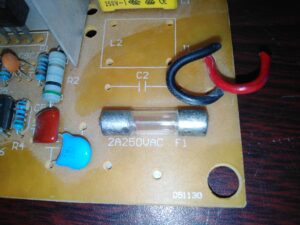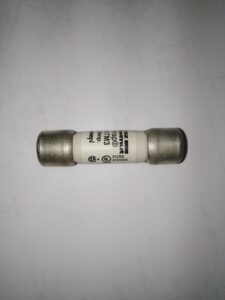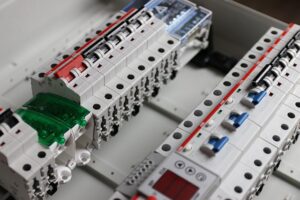In the real world, electrical engineers and electricians often come across situations where AC fuses are used in DC circuits, especially when inspecting control circuits and distribution panels. At first glance, this might seem acceptable, but it’s actually a serious safety concern.
Table of Contents
What is a Fuse?
A fuse is a safety device used in electrical systems to protect circuits and equipment from excessive current. It is designed to interrupt the flow of electricity if the current exceeds a predetermined level, preventing overheating, damage, or fire hazards.
The fuse is a simple but important protection component. Many electrical devices use a fuse as a protection device.
Fuses are one-time-use protection devices, their filament link melts down in case of fault.
How a Fuse Works:
- Under normal conditions, the current flows through the fuse element uninterrupted.
- If the current exceeds the fuse’s rated capacity due to a fault (like a short circuit or an overload), the heat generated causes the fuse element to melt.
- This breaks the circuit and stops the flow of electricity, protecting the devices and wiring downstream.
can I use ac fuse for the dc circuit?
No, it is not advisable to use an AC fuse in a DC circuit, as it may not provide adequate protection and can pose safety risks.
AC and DC circuits have different characteristics, and their fuses are designed to operate in specific conditions:
-
Arc Extinction: AC fuses are designed with features that take advantage of the natural zero-crossing points in AC waveforms to help extinguish arcs when the fuse blows. DC fuses, on the other hand, are designed to interrupt DC currents effectively, which do not naturally cross zero. Using an AC fuse in a DC circuit may result in difficulties in extinguishing arcs, potentially causing damage or fire hazards.
-
Voltage Rating: AC fuses are rated for AC voltage levels, and their voltage ratings may not be suitable for DC applications. DC voltage can create arcing across the fuse contacts more easily, which can lead to the fuse not operating as intended and failing to protect the circuit.
-
Current Rating: While the current rating of a fuse is a critical factor, it’s important to use a fuse specifically designed for DC current interruption. DC currents can have different characteristics, and DC fuses are engineered to handle them safely.
To ensure the proper protection and safety of your DC circuit, always use fuses that are specifically designed and rated for DC applications.
Using an AC fuse in a DC circuit can result in unreliable protection and potential hazards.
Does Fuse Have a Positive and a Negative End?

Fuses don’t have a specific positive or negative end like batteries or some other electrical components.
A fuse is a safety device designed to protect electrical circuits from too much current. It’s installed in the circuit to stop the flow of electricity if the current goes beyond a safe level, preventing damage or fire hazards.
Fuses work by breaking the circuit when the current exceeds their rated capacity, no matter which way the current is flowing. This means they aren’t affected by polarity. Whether the current flows from positive to negative in a DC circuit or alternates direction in an AC circuit, the fuse will function the same way.
Can Fuse Protect Against High Voltage?

No, a fuse cannot directly protect against high voltage. A fuse is designed to protect against overcurrent conditions, such as short circuits or overloads, but it is not capable of responding to excessive voltage in a circuit.
Why a Fuse Can’t Protect Against High Voltage:
- Functionality:
- A fuse operates by melting its element when the current exceeds its rated value. Voltage, on its own, does not cause a fuse to blow unless it results in an overcurrent condition.
- Voltage Rating:
- Fuses have a voltage rating, which specifies the maximum voltage they can safely handle without arcing after the fuse element melts. Exceeding this voltage can cause a dangerous arc, but the fuse itself doesn’t regulate or limit voltage.
Role of Fuses in High-Voltage Systems:
- In high-voltage systems, fuses are rated for both current and voltage. They are used to interrupt the circuit during overcurrent events in high-voltage environments, but they do not protect against the voltage itself.
Read also my article, What is Overcurrent Protection.
Is It Normal for A Fuse to Get Hot?

It is normal for a fuse to get slightly warm during operation, but it should not become excessively hot. The temperature of the fuse depends on the amount of current flowing through it and how close that current is to the fuse’s rated capacity.
Why a Fuse Gets Warm:
- Resistive Heating:
- The fuse element has some electrical resistance. When current flows through it, it generates heat due to this resistance (Ohm’s Law: P=I2RP = I^2RP=I2R).
- A small amount of heat is expected and normal.
- Near Capacity Operation:
- If the circuit is running close to the fuse’s rated current, the fuse will naturally generate more heat.
When It’s Not Normal:
- Excessive Heat:
- If the fuse becomes hot to the touch or shows signs of discoloration, this could indicate a problem, such as:
- Overloaded Circuit: The circuit is drawing more current than it should, even if it’s not enough to blow the fuse.
- Loose Connections: Poor electrical contact at the fuse terminals increases resistance and heat.
- Underrated Fuse: The fuse’s current rating is too low for the circuit’s normal operation.
- If the fuse becomes hot to the touch or shows signs of discoloration, this could indicate a problem, such as:
- Physical Damage:
- A hot fuse might lead to melting, warping, or even failure of the fuse holder, which indicates a serious issue.
Troubleshooting Steps:
- Check Current Load: Ensure the circuit is not drawing more current than the fuse’s rating.
- Inspect Connections: Make sure the fuse is seated securely and that terminals are clean and free of corrosion.
- Verify Fuse Rating: Use a fuse with the correct amperage rating for the circuit.
Should the Fuse Be on a Positive or Negative Terminal?
The fuse should be placed on the positive terminal (or the “hot” wire in AC systems) in most applications. Here’s why:
Reasons for Placing the Fuse on the Positive Terminal:
- Protection Against Faults:
- The positive terminal or hot wire is where the power originates. Placing the fuse here ensures that the entire circuit is protected from overcurrent conditions.
- If a fault occurs, the fuse will interrupt the current before it reaches the device or wiring, preventing damage or hazards.
- Safety:
- In many systems, the negative terminal is connected to ground (or chassis in vehicles). If the fuse is on the negative side, a fault might allow the circuit to remain energized, posing a shock hazard.
- Disconnecting the positive terminal ensures the circuit is completely de-energized, making it safer for maintenance or troubleshooting.
- Standard Practice:
- In most electrical standards and codes, the fuse is placed on the live or positive side to ensure consistency and proper protection.
Exceptions:
There might be rare cases in certain specialized circuits where a fuse on the negative terminal is used, but this is typically unconventional and specific to unique design requirements.
Conclusion:
To ensure proper safety and functionality, always install the fuse on the positive terminal or hot wire of the circuit. This placement maximizes protection and adheres to common electrical practices.
Don’t Leave Empty-Handed!
Install my Free Android App on Google Play:
Electrical Cables Most Common Tables “Cables Tables”
And, my Electrical Calculations App “Fast Electrical Calculator”
Discover more great content by subscribing to My channel
Looking to stay ahead of the game in the world of electrical engineering? Subscribe to my YouTube channel and gain access to exclusive content you won’t find anywhere else!
The staff I recommend
(Amazon Affiliate Links to products I believe are high quality):
- Economy 120 Volt/60Hz AC Power Source – Step-Down Voltage & Frequency Converters 1800W
- UNI-T Digital Multimeter Tester UT139C
- 50-Amp Extension Cord for RV “100ft”
- Voltage Stabilizer 110/220v
- Hair Dryer “best selling“
- TOSHIBA EM131A5C-BS Countertop Microwave Ovens
Disclaimer: This contains affiliate links to Amazon products. I may earn a commission for purchases made through these links.



